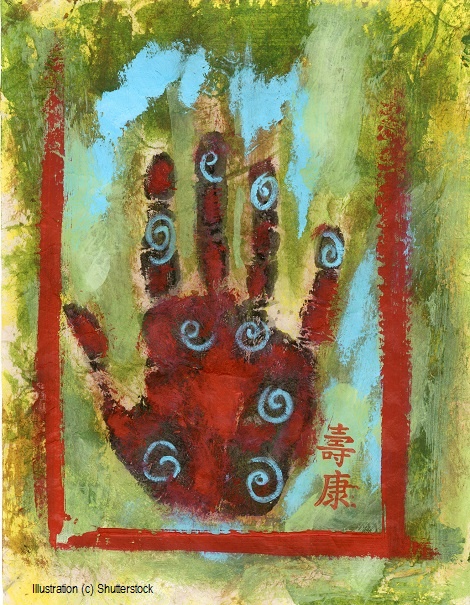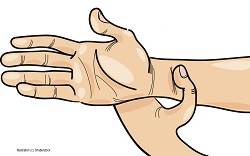|

Acupressure During Pregnancy
By Wendy Priesnitz
Acupressure can help relax the mind and body, increase blood circulation and energy levels, and help with other issues during pregnancy and childbirth, including nausea.
Acupressure can be thought of as acupuncture without the needles. Like acupuncture, its roots can be traced back over five thousand years to China. It is a bodyworking technique that involves the application of manual pressure – using the fingers, hands, or elbows – instead of needles to the same points used in acupuncture.
The points, which are sometimes called acupoints, lie along invisible lines of energy (chi) flow called meridians. In a healthy person, the energy flow through meridians is thought to be unobstructed, but the blockade of chi flow results in an illness. In Ancient Chinese Medicine, stimulating the points clears the meridians and improves the flow of energy. Western medicine suggests that this stimulation releases endorphins, which are natural painkillers, and that may lead to relaxation and normalization of body functions.
During pregnancy, treating acupressure points is a safe and drug-free way not only to relieve heartburn, nausea, and morning sickness but to help you to relax and to relieve lower back pain.
For nausea relief, the acupressure point used is called P6, or the “Inner Gate,” which is located on the inside of the arm above your wrist. First locate this acupressure point: Measure three finger widths up your arm, from the wrist line. Use your thumb to locate the exact point on the underside of your arm, in the center, where there is a hollow between the two bones and in the middle of the tendons. A slight discomfort will tell you when you’ve located the point. Press the point firmly with the ball of your thumb while you breathe out, and release pressure as you breathe in. You can repeat the pressure eight times on each wrist.
According to a 2001 Swedish study at Lund University, which involved sixty healthy women with normal pregnancies suffering from nausea and vomiting, “It is possible to reduce [nausea] significantly at P6 as compared to acupressure at a placebo point and to no treatment.”
Acupressure sea sickness bands can also be helpful for nausea relief during pregnancy. Purchased at pharmacies, these are elastic wrist bands with a small button positioned to stimulate the P6 acupressure point.
Another safe pressure point on the bottom of the foot is helpful for releasing tension and relaxing the body. Beneath the ball of the foot is a depression just as the arch begins. On a reflexology chart, this will be the “kidney” area. Place your thumb here and wrap your fingers around the top of your foot for counter pressure. Then push gently inward and upward, rolling your thumb toward the big toe. With the right pressure, and the right direction, your partner can use this technique to relax you and keep you free from anxiety during childbirth. The use of this technique is not restricted to childbirth, though, and can be used any time you need to relieve stress.
Simple acupressure can be done on oneself or by your partner. (It’s a great way for a father-to-be to become more involved in your pregnancy.) For more advanced situations, consult or get some training from a practitioner, usually an acupuncturist or other bodyworker trained in the field.
Caution is needed because stimulation of certain acupressure points can trigger contractions. (P6 isn’t one of those.) In fact, acupressure is also widely used for inducing or assisting labor of full-term pregnancies. Maternity acupressure techniques can help increase blood flow, eliminate pain, and reduce stress on the birthing mother, while helping with contractions, dilation, and providing extra oxygen to the baby.
Midwives, labor coaches, doulas, midwives, and fathers-to-be can all learn the acupressure techniques that will help with pregnancy, labor, and delivery.
Learn More
Acupressure For Women by Cathryn Bauer (Crossing Press, 1987)
Pocket Guide to Acupressure Points for Women by Cathryn Bauer (Pilgrims Publishing, 2002)
Acupressure’s Potent Points: A Guide to Self-Care for Common Ailments by Michael Reed Gach (Bantam, 1990)
Wendy Priesnitz is the editor of Natural Child Magazine, has been a journalist for forty years, and has authored thirteen books and contributed to many more.
|

